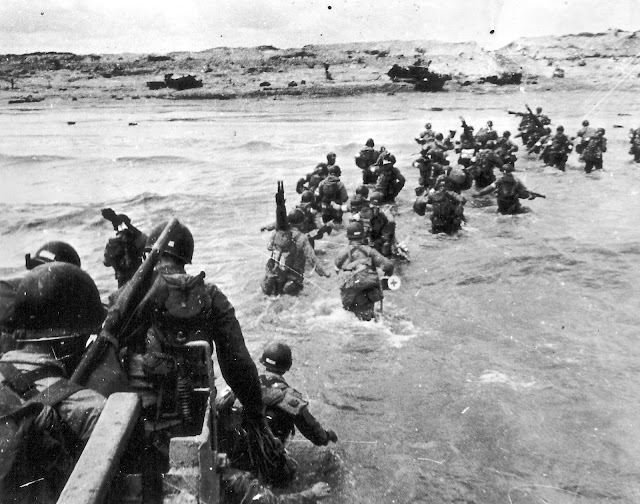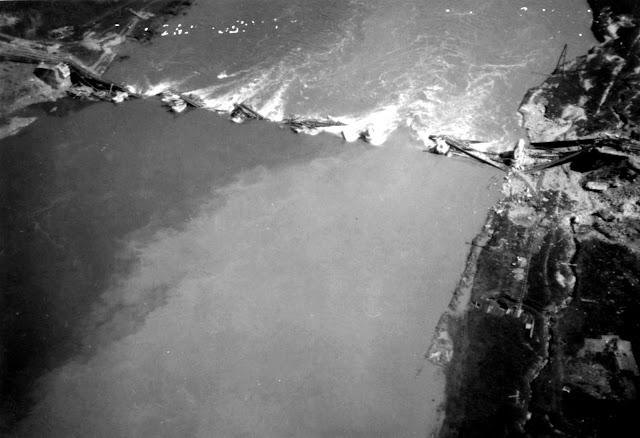MSGT. JAMES P. KELLEY, WWII/Korea: Survived WW II, Korea; killed in fall
 U.S. Marines disembark on Aug. 7, 1942 from landing craft onto Guadalcanal island in the opening invasion salvo of the first major land offensive by Allied forces against the Empire of Japan. Irvington Marine James P. Kelly would fight in the brutal, bloody Battle of Guadalcanal, codenamed Operation Watchtower, which took six months to complete and was not wound up until Feb. 9, 1943. He was part of the 1st Marine Division based in Camp Pendleton, Calif. (U.S. Marine Corps, National Archives)
U.S. Marines disembark on Aug. 7, 1942 from landing craft onto Guadalcanal island in the opening invasion salvo of the first major land offensive by Allied forces against the Empire of Japan. Irvington Marine James P. Kelly would fight in the brutal, bloody Battle of Guadalcanal, codenamed Operation Watchtower, which took six months to complete and was not wound up until Feb. 9, 1943. He was part of the 1st Marine Division based in Camp Pendleton, Calif. (U.S. Marine Corps, National Archives)
James’ father, born in Yonkers in 1888 and raised in Tarrytown, was an Ivy League-educated civil engineer who worked with at least one private firm and later the Town of Greenburgh. He also worked as a tax assessor for the Village of Irvington for seven years up to his death in November 1952. His mother was a stay-at-home mom who would die young.
James’ widowed father remarried less than two years after May's death. His new bride, the former Josephine Herlihy, brought the family to Irvington, her hometown. Josephine was 14 years James' junior, and the couple wed on Valentine’s Day in 1934.
His father and stepmother had another child, James' half-sister Joan, in 1936.
He returned to active duty in the Marine Corps in 1942 after the outbreak of war and was assigned to Camp Pendleton, Calif. Reports on his military deployments are spotty, but he fought in the Battle of Guadalcanal (Aug. 7, 1942-Feb. 9, 1943), the first land offensive by Allied forces against Japan, which had taken the British protectorate island in the Solomon Islands chain in February of 1942. He was wounded and awarded the Purple Heart, but the date and location are not available.
He was promoted through the enlisted ranks to as high as sergeant major in 1944 – after a hiccup in 1943 when he was busted down a rank from gunnery sergeant to staff sergeant after being convicted of taking an official Navy vehicle for his own use while served at Marine bases Camp Lejeune and nearby Cherry Point, both in coastal North Carolina. He quickly moved back up and attained sergeant major rank by April 1944. That is the Marine Corps’ second highest enlisted rank, only one enlisted rank higher, the singular Sergeant Major of the Marine Corps, only one Marine holding that rank at any given time.
In January 1945, Kelley married fellow Marine Josephine Busch while the two were assigned to Marine Corps Air Station Cherry Point. They went on to have three children, Michael born in 1947, Patricia born c. 1950 and Kathryn born c. 1954.
After World War II Sgt. Maj. Kelley was assigned to Tianjin, China, not far from Beijing, as the Communist forces of Mao Zedong (formerly Mao Tse-tung) and the ruling Nationalist Kuomintang forces of Chiang Kai-shek ended their wartime alliance against Japan and resumed their own civil war in China.
Kelley would spend the years between World War II (1941-45) and the Korean War (1950-53) primarily at Cherry Point. In July 1950, a month after war broke out on the Korean peninsula, Kelley was deployed to South Korea and spent a year with the 1st Marine Aircraft Wing there, before returning to Cherry Point. He would be transferred to Naval Air Station Olathe, Kansas, near the Missouri border in late 1953. The Kelley family would spend three years at Olathe before James, according to his family, voluntarily accepted the reduced rank of master sergeant to allow his deployment with the 1st Marine Aircraft Wing to Camp Foster, Okinawa, Japan. He was set to return stateside, but that changed on April 8, 1958 when he died in an ambulance en route to hospital.
Links to similar personal stories about Irvington heroes who gave their lives for their country*
◼ Pfc. Cuthbert Powell Sinkking: Class of '42 gave 3 of its own to the ages
◼ Pfc. John Joseph (Joe) Gilchrist: Died after capture of Saint-Lo
◼ Lt. (j.g.) George Eddison Haines: Lost at sea, awarded Silver Star
◼ Pfc. Joseph Thomas Costello: Teen lost life in Battle of Mindanao
◼ MSgt. James Peter Kelley: Survived WW II and Korea; died in fall
◼ S1 Archibald Ronald: Lost on next-to-last Navy ship sunk by U-boat
◼ TSgt. Raffaele R. (Ralph) Reale: A hero's life ended on East Sunnyside Lane
◼ Sgt. Robert F. Morrison: Took fight to the enemy, fell in Alsace
◼ Lt. Col. George W. Beavers Jr.: Re-upped as private; died on war's eve
◼ F2 Claude L. Bronnes: Went down with the Atlanta at Guadalcanal
◼ MMLC William James Downey: Died aboard ship off West Coast
◼ Pvt. Alick Main Ian: Died taking Aachen, first German city to fall in WWII
◼ Pfc. George Mills Hill Jr.: Survived Okinawa, only to fall in South Korea
◼ Pvt. Peter R. Robinson: Lost to shadows of time over Pacific, answers never found
WORLD WAR I











Comments
Post a Comment